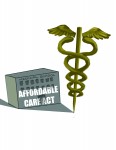California is heading the charge to implement the insurance mandate of the Affordable Care Act.
Specifically, the state is requiring all uninsured Californians to purchase health insurance. While the mandate is expected to require four to five million more Californians to buy insurance, the state does not have enough physicians to accommodate the influx of new patients.
To address this shortage of physicians, State Senator Ed Hernandez (D-West Covina) has proposed changes to allow the state to permit non-physician care providers to administer certain primary care treatments.
The proposal is meant to open alternative sources of treatment for patients and expedite primary care.
But this short-term proposal fails to address the long-term issue – expanding the responsibilities of non-physician practitioners will not increase the number of medical students studying to be primary care physicians.
If this long-term problem remains ignored, Hernandez’s proposal will only prolong California’s physician shortfall.
The Golden State’s shortage of doctors cannot be ignored. Of the 58 counties in California, only 16 support the federally recommended quantity of primary care physicians, 30 percent of whom are approaching retirement age.
For students, the benefits of a non-MD track are obvious. Non-physician providers go to school for less time, enter the field faster and pay lower educational costs.
To earn a Doctor of Medicine degree, students go through four years of education for a bachelor’s degree, an additional four years in medical school and then at least three years of residency in order to practice. Such an extended time frame makes the bolstering of the California doctor cohort a daunting task, especially when contrasted to the six- or seven-year track of non-physician healthcare professions.
And the shorter education process for the non-MD track clearly resonates with newer generations of aspiring healthcare students – even as the number of physicians stagnates or declines, the number of non-MDs such as nurse practitioners is rising.
Hernandez, who is also an optometrist, said he does not think the bill will disincentivize medical school. Other factors such as compensation for specialists already drive medical students away from primary care, he said.
Still, the real problem lies in attracting more students to become physicians, specifically primary care physicians. The proposal could further aggravate a migration away from medical school, which in turn will fail to increase the number of physicians.
Since non-physicians will now be able to practice some of the same medicine as their primary care counterparts, it is reasonable to expect that certain medical students might choose these non-physician careers that practice the same medicine without the heavy cost of residency.
Daniel O’Brien, a fourth-year biochemistry student on the pre-medical track, said the legislation might encourage him to rethink the years required by medical school.
This proposal will alleviate the immediate strain on healthcare in California, but it will not address the systemic issue. So while Hernandez is moving in the right direction, the proposal is ultimately short-sighted.
Email Padgett at hpadgett@media.ucla.edu. Send general comments to opinion@media.ucla.edu or tweet us @DBOpinion.
